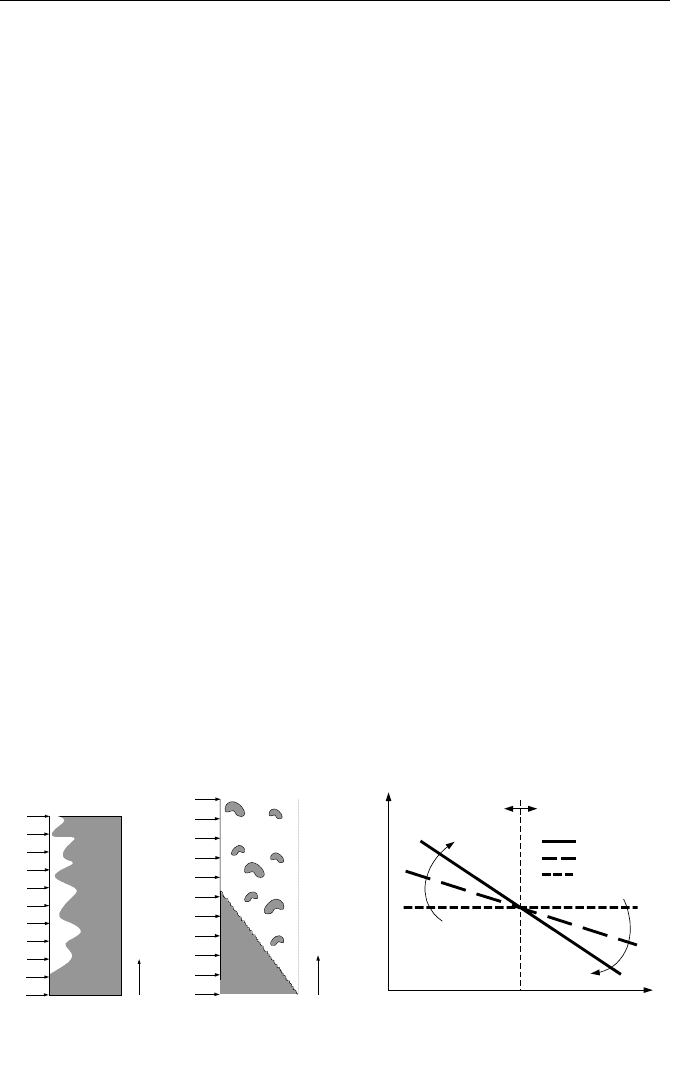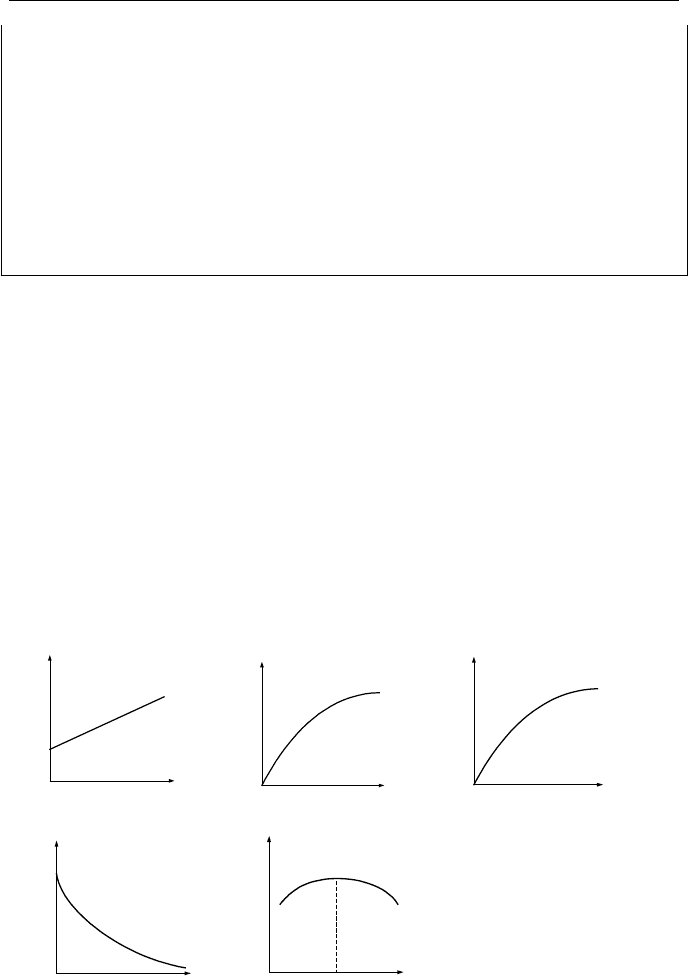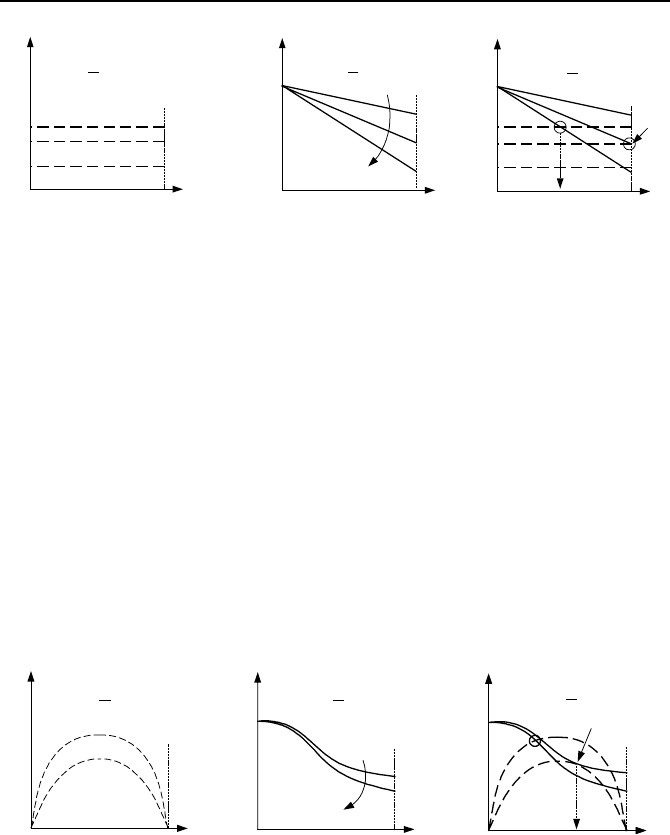Massoud M. Engineering Thermofluids: Thermodynamics, Fluid Mechanics, and Heat Transfer
Подождите немного. Документ загружается.


662 Vb. Two-Phase Flow and Heat Transfer: Boiling
CHF
q
′′
Flow
Liquid
Vapor
Flow
Liquid
Vapor
Liquid
CHF
q
′′
DNB
Region
Dryout Region
High G
Medium G
Low G
x
CHF
q
′′
G
G
(a) (b) (c)
Figure Vb.5.2. De
p
iction of (a) DNB, (b) Dr
y
out, and (c) De
p
endenc
y
of CHF on Mass
Flux (Todreas)
In the above examples, surface temperature was specified. Otherwise, we
should solve the problem by iteration. In an iterative solution, we assume a value
for the surface temperature to find
∆T
sat
and subsequently calculate h
Chen
from the
Chen correlation, Equation Vb.5.1b. Having h, we then recalculate
∆T
sat
from a
heat balance between the surface and the fluid;
sat
Thq ∆=
′′
. We continue this
until we reach the intended convergence criterion, for example
ε
≤ 1%. Kandlikar
has introduced a more recent correlation, which, according to Lienhard, leads to
mean deviations of 16% for water and 19% for refrigerants.
5.3. Critical Heat Flux in Flow Boiling
Due to the importance of flow boiling especially in the operation of nuclear reac-
tors, extensive research has been performed in flow boiling CHF. The CHF
mechanism in flow boiling is a function of the flow regime and is either in the
form of departure from nucleate boiling, DNB, or dryout. DNB is the mechanism
of concern in the design and operation of PWRs. A PWR core contains pressur-
ized subcooled water. In a high power channel, the rate of vaporization at the sur-
face may become so vigorous that it may prevent liquid from reaching the surface,
Figure Vb.5.2(a). Depriving the surface of liquid for nucleation results in elevated
surface temperature, which may lead to fuel failure. On the other hand, the dryout
mechanism is of concern in the design and operation of BWRs. This is because,
in high power channels, the flow regime may become annular. With further in-
crease in power, the liquid film may simply dryout as shown in Figure Vb.5.2(b).
For this reason, the operational heat flux is maintained well below the CHF,
through the application of a variety of safety factors. As shown in Fig-
ure Vb.5.2(c), the magnitude of CHF is either a direct or an inverse function of the
mass flux, depending on quality. In the DNB region (low x), CHF is a direct func-
tion of mass flux whereas in the dryout region (high x) CHF depends inversely on
mass flux.
There are many CHF correlations for water in the literature, including Bab-
cock & Wilcox, Combustion Engineering, EPRI, General Electric, Westinghouse,

5. Flow Boiling Modes 663
Barnett, Biasi, Bernath, Bowring, Gaspari (CISE-4), and Katto. Next we discuss
several of these correlations.
Barnett correlation. The critical heat flux in this correlation is expressed in
terms of channel geometry (hydraulic diameter, heated diameter and heated
length) as well as coolant mass flux and specific enthalpies. The Barnett correla-
tion covers a narrow range for pressure (i.e., 4 – 10 MPa). The Barnett correlation
in SI units is given as:
zC
hhChC
q
iffg
CHF
37.39
)(103.4584.3
101546.3
3
2
4
1
6"
+
−×+
×=
−
Vb.5.2
where constants C
1
, C
2
, and C
3
are expressed in terms of G and D as
[]
)3477.0exp(744.017.230
192.068.0
1
GDGDC
eh
−−= ,
817.0415.1
2
1206.0 GDC
h
= , and
212.0415.1
3
8249 GDC
e
= .
Bernath correlation is
CHF
q
′′
=
,
()
CHF s CHF
f
hT T− where
CHF
h and
,
s
CHF
T
are in turn obtained from the following relations:
6.0
48
)/P(1
1
890,10
e
eh
CHF
D
V
D
h
+
+
=
π
V
P
PT
CHFs
45.0
)/15(1
2.97
ln6.10232
,
−
+
−+=
where P is system pressure in psia, V is coolant velocity in ft/s, T
f
is bulk tempera-
ture of the coolant in F, D
e
is the equivalent diameter in ft and P
h
is the heated pe-
rimeter in ft. This correlation is valid for pressure ranging from 23 – 3000 psia,
coolant velocity in the range of 4.0 – 54 ft/s, and equivalent diameter in the range
of 0.143 – 0.66 in.
Biasi correlation expressed in terms of pressure, mass flux, quality, and
diameter, has a much wider range of application for pressure compared to the Bar-
nett correlation. Since the database covers both low and high steam quality, the
Biasi correlation is applicable to both DNB and dryout. In SI units, the Biasi cor-
relation for G < 300 kg/s·m
2
is given as:
()
xSq
CHF
−= 1
1
"
Vb.5.3
where S
1
= 15.048E7(100D)
–n
G
–1/6
C
1
and heat flux is in W/m
2
. For mass fluxes
higher than 300 kg/s·m
2
, the heat flux in W/m
2
is obtained from:
()
xSSq
CHF
−=
32
"
Vb.5.4

664 Vb. Two-Phase Flow and Heat Transfer: Boiling
where S
2
=
()
617
10010764.2
−
−
× GD
n
and S
3
=
61
2
468.1
−
GC . In Equations
Vb.5.3 and Vb.5.4, constants C
1
and C
2
are only functions of pressure and are
given as
()
12
1
)101(919.0exp49.1159.1
−
++−+−= PPPPC and
()
PPC 32.0exp99.07249.0
2
−+=
Exponent n is 0.4 if the D
channel
≥ 0.01 m. Otherwise, its value is 0.6. Also P is in
MPa.
If the channel is heated uniformly, an energy balance for a control volume ex-
tended from the inlet to height z (where CHF occurs) gives:
)()4/()(
2
il
hhGDDzq −=
′′
ππ
Vb..5.5
Substituting for the local enthalpy from h
l
= h
f
+ x
l
h
fg
in Equation Vb.5.5, solving
for x
l
and substituting into Equations Vb.5.3 and Vb.5.4, the Biasi correlation for
uniformly heated tubes becomes:
)1/()1(
11
"
SSq
CHF
αβ
++=
Vb.5.3
()( )
232
"
1/ SSSq
CHF
αβ
++=
Vb.5.4
where
α
= 4z/(GDh
fg
) and
β
= ∆h
sub,i
/h
fg
.
Bowring correlation has a wide range of applicability. It is based on the
works of MacBeth and Barnett and in SI units is given as:
()
321
"
/ CxhCCq
fgCHF
−=
Vb.5.6
where coefficients C
1
, C
2
and C
3
are functions of pressure, mass flux and channel
diameter as follows:
GDC
hCC
C
fg
2/1
5
42
1
0143.01
317.2
+
=
,
4
2
DG
C
= ,
()
n
GC
CC
C
1356/347.01
308.0
7
62
3
+
=
where exponent n is a function of the reduced pressure (i.e., n = 2 – 0.5P
R
). The
reduced pressure in turn is defined as P
R
= 0.145P MPa. Coefficients C
4
through
C
7
are functions of reduced pressure. For P
R
< 1 MPa;
()
[]
RR
PPC −+= 189.20exp52.0478.0
942.18
4
,
()
[]
{}
1
316.1
45
1444.2exp764.0236.0
−
−+=
RR
PPCC ,
()
[]
RR
PPC −+= 1658.16exp6.04.0
023.17
6
, and
649.1
67
R
PCC =
and for P
R
> 1 MPa, the above coefficients are given as:

5. Flow Boiling Modes 665
()
[]
RR
PPC −=
−
1648.0exp
368.0
4
,
()
[]
{}
1
448.0
45
1445.2exp
−
−
−=
RR
PPCC ,
219.0
6
R
PC = ,
649.1
67
R
PCC = .
For uniformly heated channels, we use Equation Vb.5.5 and substitute h
l
= h
f
+
x
l
h
fg
. The same procedure was used for the Biasi correlation to write the Bowring
correlation as:
zC
hCC
q
sub
CHF
+
∆+
=
′′
3
21
Vb.5.7
CISE-4 correlation is applicable to BWRs and has a narrow range of applica-
tion for both pressure and mass flux. This correlation is expressed in terms of
CHF quality (x
CHF
) whose value approaches unity when mass flux approaches 0.0.
This correlation in SI units is given as:
¸
¸
¹
·
¨
¨
©
§
+
=
CHF
CHF
e
h
CHF
LC
LC
D
D
x
2
1
Vb.5.8
where C
1
and C
2
are functions of mass flux, pressure and critical pressure: The
value of coefficient C
1
depends on mass flux as compared with a reference flux
(G
R
given by
()
3
/13375
cR
PPG −= ). Hence;
()
[]
1
3
4
1
/110481.11
−
−
−
−×+= GPPC
c
;
R
GG ≤
()()
3/1
1
1000//1
−
−= GPPC
c
;
R
GG >
and coefficient C
2
is given by
()
4.1
4.0
2
1/199.0 GDPPC
c
−= . Also L
CHF
is the
boiling length to the point where CHF occurs. To find
CHF
q
′′
by the CISE–4 cor-
relation, we need to find relations for x
CHF
and L
CHF
. To find L
CHF
, we use an en-
ergy balance, Equation Vb.5.5. If the entire tube is uniformly heated at
CHF
q
′′
, the
portion of energy consumed to bring the subcooled water at the inlet of the tube to
saturation, is found from:
[]
()
)(4/)(
2
infCHFCHF
hhDGLLDq −=−
′′
ππ
Similarly, we can find x
CHF
from Equation Vb.5.6 applied to the boiling section:
()
()
()
fgCHFfCHFCHF
hxDGhhDGDLq 4/4/
22
πππ
=−=
′′
Eliminating L
CHF
between these equations and substituting, we obtain x
CHF
as:
[
]
[
]
fginffgCHFCHF
hhhGDhqLx /)()/(4 −−
′′
=
Vb.5.9

666 Vb. Two-Phase Flow and Heat Transfer: Boiling
Substituting into Equation Vb.5.8, we find the following implicit equation for
CHF
q
′′
:
()
(
)
[
]
yhhLCDDChy
infehfg
///
21
−−+= Vb.5.10
where in Equation Vb.5.10, y = 4
CHF
q
′′
/(GD).
EPRI-1 correlation as reported by Pei, is based on a vast bank of data:
()
linl
in
CHF
qxxC
xC
q
′′
−+
−
=
′′
/
2
1
Vb.5.11
where
l
q
′′
is the local heat flux and both heat flux terms in Equation Vb.5.11 are
in MBtu/h·ft
2
. Mass flux G is in Mlbm/h·ft
2
. Coefficients C
1
and C
2
are given as:
C
1
=
)(
1
75
2
r
PPPP
r
GPP
+
C
2
=
)(
3
86
4
r
PPPP
r
GPP
+
Note the reduced pressure is P
r
= P/P
critical
. Constants P
1
through P
8
are given as
P
1
= 0.5328, P
2
= 0.1212, P
3
= 1.6151, P
4
= 1.4066, P
5
= –0.3040, P
6
= 0.4843, P
7
= –0.3285, and P
8
= –2.0749.
For uniformly heated channels, we may substitute for the local quality from x
l
=
(h
l
– h
f
)/h
fg
and for the local heat flux from Equation Vb.5.5 to write the EPRI-1
correlation as:
()
[]
fg
in
CHF
GDhzC
xC
q
/4
2
1
+
−
=
′′
Vb.5.12
Katto correlation (Collier) is expressed in terms of quality, mass flux, and en-
thalpy as:
(
)
[
]
iffgCHF
hhKhXGq −+=
′′
Vb.5.13
where h
i
is the inlet enthalpy calculated at P and T
i
. Coefficients X and K in Equa-
tion Vb.5.13 are functions of dimensionless numbers Z, R, and W defined as:
D
z
Z
= ,
g
f
R
ρ
ρ
= ,
2
zG
W
f
σρ
=
We need to calculate five values for X and three values for K as follows:
ZCWX /
043.0
1
= , yZWRX /1.0
433.0133.0
2
= ,
yZWRX /098.0
27.0433.0133.0
3
= ,

5. Flow Boiling Modes 667
()
ZWWRX
233.0173.06.0
4
28.01/0384.0 += ,
yZWRX /234.0
27.0433.0513.0
5
=
()
043.0
1
/261.0 CWK = ,
[
]
()
333.0133.01
2
/0124.0833.0 WRZK
−
+= ,
[
]
()
173.06.01233.0
3
/52.112.1 WRZWK
−
+=
where y = 1 + 0.0031Z and the value of C in these relations is found as:
C = 0.25 if Z < 50,
C = 0.25 + 0.0009(Z – 50) if 50 < Z < 150,
C = 0.34 if Z > 150.
The following logic should be used to find the applicable values of X and K:
R < 0.15
If X
1
< X
2
, X = X
1
If X
1
> X
2
and X
2
< X
3
, X = X
2
If X
1
> X
2
and X
2
> X
3
, X = X If K
1
> K
2
, K = K
1
If K
1
< K
2
, K = K
2
R > 0.15
If X
1
< X
5
, X = X
1
If X
1
> X
5
and X
4
< X
5
, X = X
5
If X
1
> X
5
and X
4
> X
5
, X = X
4
If K
1
> K
2
, K = K
1
If K
1
< K
2
and K
2
< K
3
, K = K
2
If K
1
< K
2
and K
2
> K
3
, K = K
3
General Electric correlation, devised for BWRs, expresses the lowest meas-
ured values of critical heat flux as a function of mass flux and quality:
Gq
CHF
237.0705.0 +=
′′
X < C
1
XGq
CHF
71.427.0634.1 −−=
′′
C
1
< X < C
2
XGq
CHF
653.0164.0605.0 −−=
′′
C
2
< X
where constants C1 and C2 are given in terms of mass flux:
C
1
= 0.197 – 0.108G
C
2
= 0.254 – 0.026G
In these relations, X is the flow quality, mass flux G is in Mlbm/h·ft
2
, and heat flux
CHF
q
′′
is in MBtu/h·ft
2
. The above relations apply to a system at a pressure of
1000 psia. For other pressures, we find
CHF
q
′′
from:
)1000(440)1000()( PqPq
CHFCHF
−+
′′
=
′′
The GE correlation is valid for P in the range of 600 – 1450 spia, G in the range of
0.4 – 6 Mlbm/h·ft
2
, quality in the rage of 0 – 0.45, channel length in the range of
29 – 108 in, and equivalent diameter in the range of 0.245 – 1.25 in. As reported

668 Vb. Two-Phase Flow and Heat Transfer: Boiling
by Tong, the GE lower envelope correlation for low mass velocity CHF at pres-
sures less than 1000 psia is obtained from:
xq
CHF
−=
′′
84.0
, G < 0.5 Mlbm/h·ft
2
xq
CHF
−=
′′
80.0
, 0.5 < G < 0.75 Mlbm/h·ft
2
where the critical heat flux is in MBtu/h·ft
2
. The range of applicability of these
correlations are shown in Table Vb.5.1.
Table Vb.5.1. Data base for various CHF correlations
Correlation D (m) L (m) P (MPa) G (kg/m
2
s)
Biasi 0.0030 – 0.3750 0.20 – 6.00 0.27 – 14 100 – 6000
Bowring 0.0020 – 0.0450 0.15 – 3.70 0.20 – 19 136–18,600
Barnett 0.0095 – 0.0960 0.61 – 2.74 6.9 190 – 8409
CISE-4 0.0102 – 0.0198 0.76 – 3.66 4.96 – 7.0 1085 - 4069
EPRI-1 0.0420 – 0.0139 0.76 – 4.27 1.38 – 17 271 – 5553
Katto 0.0010 – 0.038 0.01 – 8.80 00.1 – 21*
**
General Electric 0.0060 – 0.0320 0.74 – 2.74 4.14 – 10 550 – 8000
* Specified in terms of 0.0003 <
ρ
g
/
ρ
f
< 0.41. ** Specified in term of 3E-9 < W < 2E-2.
Predictions of several CHF correlations are compared in the following example.
Example Vb.5.3. Water at 288 C (550 F) enters a uniformly heated vertical tube
of diameter 13.4 mm (0.528 in) and length 3.66 m (12 ft) at 3508 kg/s·m
2
(2.59
Mlb/s·ft
2
). The system pressure is 15.51 MPa (2250 psia). Find CHF from the
Biasi, the Bowring, the EPRI-1, and the Katto correlations.
Solution: We first find water properties at 15.51 MPa: h
f
= 1631 kJ/kg (701 Btu/
lbm), h
g
= 2600 kJ/kg (1118 Btu/lbm), h
fg
= 969 kJ/kg (417 Btu/lbm), h
i
(P = 15.51
& T = 288) = 1273.7 kJ/kg (547 Btu/lbm).
Biasi correlation: Since G > 300 kg/s·m
2
, we use Equation Vb.5.4:
()
12
1
)101(919.0exp49.1159.1
−
++−+−= PPPPC = 0.1123
()
PPC 32.0exp99.07249.0
2
−+= = 0.8322
S
2
=
()
617
10010764.2
−
−
× GD
n
= 0.5949E7,
S
3
=
61
2
468.1
−
GC = 0.3134
α
= 4z/(GDh
fg
) = 4 × 3.66/(3508 × 0.0134 × 969E3) = 3.2E–7
β
= (h
f
– h
in
)/h
fg
= (1631 – 1273)/2600 = 0.3686
()( )
232
"
1/ SSSq
CHF
αβ
++=
= 0.5949E7 × (0.3134+0.3686)/(1 + 3.2E–7 ×
0.5949E7) = 1.39 MW/m
2

5. Flow Boiling Modes 669
Bowring correlation: We first obtain C
4
= 0.478, C
5
= 0.4912, C
6
= 0.4, and C
7
=
0.0345. We then find:
()
=+= GDChCCC
fg
2/1
5421
0143.01/317.2 0.3274E7, C
2
= DG/4 = 11.75,
()
[
]
n
GCCCC 1356/347.01/308.0
7623
+= = 1.3507
()()
zChCCq
subCHF
+∆+=
′′
321
/
= (0.3274E7 + 11.75 × (1631 – 1273.7)E3/
(1.3507 + 3.66) = 1.49 MW/m
2
EPRI-1 correlation: We use Equation Vb.5.12 for which we find coefficients C
1
and C
2
from:
C
1
=
)(
1
75
2
r
PPPP
r
GPP
+
= 0.5328 × (2250/3205.6)
0.1212
× 2.56
[–0.3040 – 0.3285 ×
(2250/3205.6)]
= 0.3069
C
2
=
)(
3
86
4
r
PPPP
r
GPP
+
= 1.6151 × (2250/3205.6)
1.4066
× 2.56
[0.4843 – 2.0749 × (2250/3205.6)]
= 0.3892
(
)
()
[]
fg
fgisub
CHF
GDhzC
hhC
q
/4
/
2
,1
+
∆+
=
′′
=
()
()
0.3069 [ 701 547 / 417]
0.3892 4 3.66 /(2.59 0.0134 417
+−
+× × ×
0.48 MBtu/h·ft
2
= 1.52 MW/m
2
Katto correlation: We first find Z = z/D = 272.95, R =
ρ
g
/
ρ
f
= 0.17, and W =
0.65E-7. Now find X
i
& K
i
:
X
1
= 0.6114E-3, X
2
= 0.1732E-3, X
3
= 0.1475E-3, X
4
= 0.2881E-3 X
5
= 0.1803E-3,
K
1
= 1.564, K
2
= 4.185, K
3
= 2.022.
Using the selection logic, we find X = 0.2881E-3 and K = 2.022
(
)
[
]
iffgCHF
hhKhXGq −+=
′′
= 0.2881E-3 × 3508[969E3 + 2.022(1631 –
1273.7)E3] = 1.71 MW/m
2
Example Vb.5.4. Water at 400 F and 1000 psia enters a uniformly heated channel
at a rate of 1E6 lbm/h·ft
2
. The channel heated and equivalent diameters are D
h
=
D
e
= 0.3 in. Channel length is 1.5 ft. Find the critical heat flux and wall tempera-
ture at CHF.
Solution: We first use a CHF correlation, such as EPRI-1 for example to find the
critical heat flux:
()
()
()
()
1
,
2
/
0.4627 166.5/ 650.5
0.3140 4 1.5/1 0.025 650.5
4/
sub i fg
CHF
fg
Chh
q
CzGDh
+∆
+
==
′′
+× × ×
+
= 1.05E6 Btu/h·ft
2

670 Vb. Two-Phase Flow and Heat Transfer: Boiling
The solution to find T
CHF
is basically iterative. However, we may use the Bernath
correlation to find the onset of the boiling crisis. For this purpose, we need the lo-
cal enthalpy:
h
l
= h
i
+ (4z
CHF
q
′′
/GD) = 375.8 + [4 × 1.5 × 1.05/(1 × 0.025)] = 627.8 Btu/lbm
Density at the onset of CHF is
ρ
=
ρ
(1000 psia, 627.8 Btu/lbm). Hence,
ρ
l
= 46.3
lbm/ft
3
:
V = G/
ρ
= (1E6/3600)/46.3 = 6 ft/s
()
[]
645.01000/151/2.971000ln6.10232
,
×−+−+=
CHFs
T = 642.3 F.
5.4. Factors Affecting CHF
Critical heat flux correlations show the dependency of CHF on flow path diameter
(d), flow path length (L), mass flux (G), inlet subcooling (
∆h
in
), and pressure (P).
To determine the effect of each parameter, the rest of the parameters are kept con-
stant. Let’s first consider the case of upward flow of a liquid in a heated tube hav-
ing diameter d and length L. Figure Vb.5.3 shows that CHF varies directly with
∆h
in
, G, and d and varies inversely with L. Pressure has a more interesting effect
as CHF for water in both pool and flow boiling reaches a maximum at about
70 bar. To investigate the effect of heat flux on CHF, we try three cases of low,
medium, and high heat fluxes, as shown by dashed lines 1, 2, and 3 in Fig-
ure Vb.5.4(A).
∆h
in
CHF
q
′′
L, d, G, P
G
CHF
q
′′
L, d, ∆h
in
, P
d
CHF
q
′′
L, G, ∆h
in
, P
L
CHF
q
′′
d, G, ∆h
in
, P
P (bar)
CHF
q
′′
L, d, G, ∆h
in
70 1104010
For Water
Figure Vb.5.3. Effect of various design parameters on CHF (Whalley)

5. Flow Boiling Modes 671
x
q
′′
3
2
1
L L
1
2
3
q
′′
CHF
q
′′
x
L
1
2
3
CHF
q
′′
3
2
1
x
A B
C
Figure Vb.5.4. Effect of uniform heat flux on critical heat flux
Expectedly, the critical heat flux correlations show that CHF inversely depends
on heat flux. This is shown in figure B. Superimposing figures A and B, we ob-
tain figure C. Let’s examine this figure. We observe that at low heat flux (dashed
and solid lines 1), CHF does not occur. When we increase heat flux, (dashed and
solid lines 2), they intersect right at the tube exit. If we further increase heat flux,
CHF occurs at a lower part of the tube (intersection of dashed and solid lines 3).
The point at which CHF occurs moves towards the exit of the tube, as the heat
flux is reduced. Hence, in uniformly heated channels, CHF always occurs first at
the exit of the channel. Let’s us now examine the case of non-uniform heat flux,
which is the case in the core of nuclear plants. Since neutron flux has a sinusoidal
distribution in the axial direction, heat flux has also a sinusoidal distribution, as
shown in Figure Vb.5.5 (A). In this figure, two curves are shown for low heat flux
(curve 1) and for high heat flux (curve 2). CHF versus tube length for the same
two heat fluxes is shown in figure B. We obtain figure C by superimposing fig-
ures A and B. As seen in figure C, CHF occurs first in the upper part of the tube.
As heat flux is increased, then CHF occurs at other locations along the tube.
x
q
′′
2
1
L L
1
2
q
′′
CHF
q
′′
x
x
2
1
L
1
2
CHF
q
′′
A B
C
Figure Vb.5.5. Effect of non-uniform heat flux on critical heat flux
5.5. Transition Flow Boiling
In temperature controlled flow boiling, transition to film flow boiling occurs when
the local heat flux exceeds the CHF. In this regime, heat transfer alternates be-
tween nucleate and film boiling regimes. The heat transfer coefficient for transi-
tion boiling may be calculated from the McDonough correlation:
